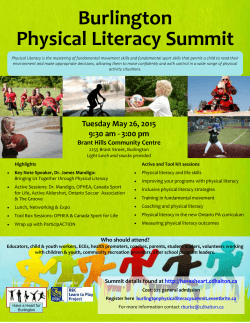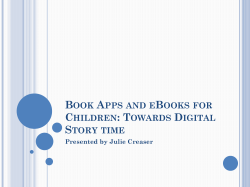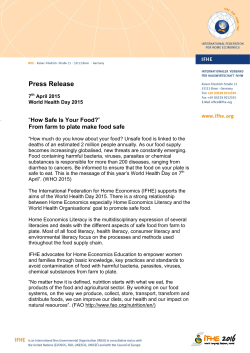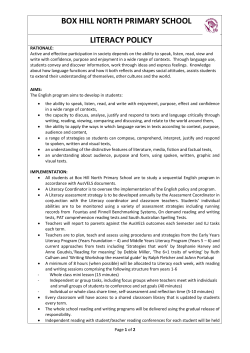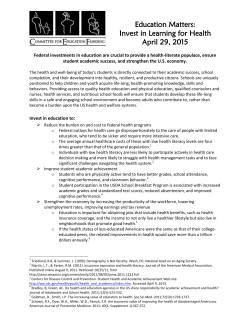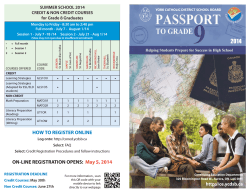
Participatory Literacies in a Community-Wide Reading
“Who are Our Mockingbirds?”: Participatory Literacies in a Community-Wide Reading Program Deborah Vriend Van Duinen Kathryn Schoon-Tanis ABSTRACT: Drawing on sociocultural perspectives of literacy, this Voices From the Field paper presents artifactual data collected during a community-wide reading program of To Kill a Mockingbird. During this program, over 400 high school students and community members participated in an art project in which they artistically responded to the question, “Who are the mockingbirds?” by reflecting on marginalized or oppressed people in their community. Findings suggest that there was significant variation in how participants artistically responded to the question prompt; there were differences in how participants drew on their own literacies to complete the project, how they visually communicated their ideas, and how they defined the community or audience for their work. These findings suggest that more attention to embodied literacies, visual and critical visual literacy practices, and place-based pedagogies, is needed in both school and out-of-school contexts. Throughout the article, we provide several images of the completed individual mockingbirds as well as an image of the final collaborative mockingbird project. Key words: Literature, Aesthetic Education, Community Literacy, Critical Visual Literacy, To Kill a Mockingbird Deborah Vriend Van Duinen, Ph.D is an assistant professor of Education and a Towsley Research Scholar at Hope College in Holland, MI where she teachers content area literacy and English Education classes. Her research interests include adolescent literacy and YA literature. Deborah has published in a variety of journals including Journal of Adolescent and Adult Literacy and English Journal. She recently wrote a chapter in Research on Teaching and Learning with the Literacies of Young Adolescents (2015). She can be contacted at vanduinen@hope.edu Kathryn Schoon-Tanis, Ph.D teaches rhetoric and composition of popular culture in the English department at Hope College. She recently co-authored Can Pop Culture and Shakespeare Exist in the Same Classroom?: Using Student Interest to Bring Complex Texts to Life (2014). She was previously a high school English teacher. She can be contacted at schoontanisk@hope.edu Journal of Language and Literacy Education Vol. 11 Issue 1 -- Spring 2015 Michelle M. Falter, Editor -- http://jolle.coe.uga.edu Vriend Van Duinen, D., & Schoon-Tanis, K. (2015) / “Who are our mockingbirds?” Vignette 1 there were 30 book discussions and several art projects that encouraged participants to explore ideas from the book in visually creative ways. Seven area schools (public, private, and charter) participated in the program by having English Language Arts (ELA) classes read the book, attend main events, and collaborate with a professional artist. With trembling hands, Alan clutched a paper in the shape of a mockingbird and stood in front of his 9th grade English class. “I think that mockingbirds today are gay people,” he said, his voice shaking. He continued, “And people who think that maybe they are gay but don’t feel like they can talk about it with anyone.” He paused and then held up his mockingbird, a rainbow of colors filled the body of the mockingbird. “GLBTQ” was written across the breast of the bird. The classroom was silent, and then, as if on cue, Alan’s fellow students started enthusiastically clapping. Our experiences as organizers of this communitywide reading program offered us a way to explore how, as Behrman (2006) noted, “The community in which the reader or writer participates may shape both the content and form of the literate action” (p. 26). In this Voices From The Field article, we share our reflections on one aspect of this community-wide reading program—a mockingbird art project that involved over 400 people ranging in age from school children to senior citizens. With crayons, markers, colored pencils, and paint, participants drew in, and sometimes around, a mockingbird template after reading To Kill a Mockingbird, or in the case of young children, a similarly themed book. The final product was a large, colorful mockingbird collage that included over 100 of these individually decorated mockingbirds and that was revealed during the closing event of the reading program, an art reception at a local art museum. Today, the large mockingbird is displayed in the college library. Vignette 2 “Come over here Mom and Dad!” Amanda said in an excited voice. “That’s my mockingbird! That’s the one that I did! Can you see it?” Amanda pointed to one of the many mockingbirds in the large collage that was displayed in the museum lobby. Amanda’s parents and older sister crowded around and looked closely at the black and white striped mockingbird that she was pointing to. Across the bird’s body were the words, “Mental Illness,” “Crazy,” and “Depression.” On the rest of the bird, concentric lines filled the space. Behrman (2006) wrote, “Reading and writing are social as well as personal activities. Literate action requires the transposition of thought into symbolic form that can be conveyed to others or to self. Therefore, literacy is particularly affected by our involvement in a community” (p. 26). In this quote, two questions are implied: What does it mean to transpose thought into symbolic form? How does community involvement particularly affect literacy? These two questions—questions about embodied (transposing thought into symbolic form) and participatory literacy (involvement in community)— set the stage for the two vignettes described above. We focused our attention on the mockingbird project because of the ways it encouraged participants to embody literature by enacting a response to a literary text through the creation of a piece of art. We observed that the project encouraged a deeper response to a well-known piece of American literature but, perhaps more importantly, a space in which to use themes in the novel to speak to others. This space, much like what Greene (1986) called “aesthetic education” (p. 57), helped participants in our project “to create, to think, and to imagine beyond the literary text” (Pinhasi-Vittorio & Vernola, 2013, p. 69). This project helped to provide a space for marginalized voices to be recognized and, for some, the opportunity to speak out. Both vignettes took place during a one-month community-wide reading program of Harper Lee’s To Kill a Mockingbird (1982) that was led by a small liberal arts college located in a Midwest city in partnership with the local public library and a number of local organizations and businesses. As part of the programming, there were seven main events that were free and open to the public. In addition, In sharing our reflections, we hope to encourage others—ELA classroom teachers, teacher educators, community literacy leaders, and literacy researchers—to try out their own versions of this 128 Journal of Language and Literacy Education Vol. 11 Issue 1 -- Spring 2015 project using their own variations of art education, embodied literacy, critical visual literacy, and placebased pedagogy. book, Scout Finch asks her neighbor, Miss Maudie, what her father, Atticus, meant when he said that “it’s a sin to kill a mockingbird.” Miss Maudie responds, “Your father’s right … Mockingbirds don’t do one thing but make music for us to enjoy … they don’t do one thing but sing their hearts out for us. That’s why it’s a sin to kill a mockingbird” (Lee, 1982, p. 90). At the end of the book, Scout realizes the truth of this when she tells Atticus that hurting Boo Radley would be “sort of like shootin’ a mockingbird” (Lee, 1982, p. 276). Scout’s ability to identify an embodied mockingbird changes her perspective on Boo—a symbol of people who are marginalized and oppressed—on her community, and on herself. The Mockingbird Art Project In envisioning this collaborative, communal art project, we drew on sociocultural perspectives of literacy and the idea that literacy is “multiple and situated … [and includes an] interplay between the meanings of local events and a structural analysis of broader cultural and political institutions and practices” (Hull & Schultz, 2001, p. 585). We also drew on concepts within critical literacy (Freire, 2007; Lankshear & McLaren, 1993) and, specifically, In this spirit of social justice, we The project helped to critical visual literacy that wanted our project to encourage provide a space for suggests language (spoken, participants to do the same. Using marginalized voices to be written, and heard), texts, the question, “Who are the and images offer ways to mockingbirds?”, we designed the recognized and, for some, question the social mockingbird activity so that the opportunity to speak construction of self and participants could reflect on the out. others (Shor, 1999), and mockingbirds that might exist in that public art and the their own lives as well as in the life collaborative creation of it can help develop notions of our community. We developed a mockingbird of civic literacy and engagement (Charest, Bell, template (see Image 1) and a set of instructions on Gonzalez, & Parker, 2014; Johnson & Vasudevan, how to respond to the question we posed (see Table 2012). 1). Given this, we hoped to accomplish several goals with our mockingbird project. We wanted to involve as many people as possible; we wanted to accommodate different ages and experiences with the novel as well as varying time constraints and resources. We also wanted to encourage participants to connect current events to the book’s themes by drawing on their personal interests and literacies to inform and guide their work. In this, we wanted them to be more than just consumers of texts; we wanted them to be producers of texts that showed evidence of “questioning the world and the word” (PinhasiVittorio & Vernola, 2013, p. 69). Lastly, we wanted the final product to be a large art piece displayed in a public setting. Image 1. Mockingbird template (created by artist Joel Schoon-Tanis). Together with professional artist Joel Schoon-Tanis, we decided on the mockingbird as our motif for the project because of how the mockingbird is used as a central theme in the novel. Halfway through the During our month of programming, we distributed mockingbird templates at our main events, public book discussions, and children’s activities. In each of these contexts, the mockingbird project was used 129 Vriend Van Duinen, D., & Schoon-Tanis, K. (2015) / “Who are our mockingbirds?” differently. At our main events, we encouraged people to take the templates, complete them at home, and then bring them back to the public library. At the book discussions, we encouraged participants to use the particular book discussion to inform their creative work. At the children’s activities, we asked children to decorate and color the mockingbirds. We also gave the templates to our five main partner schools so that teachers and students could participate. While not all of these completed mockingbirds were used in the final piece, over 100 of them were collaged in the shape of a large mockingbird that was revealed at our closing event (see Image 2). Image 2. Completed collaborative mockingbird project. Table 1 Mockingbird Art Project Instructions Who were the mockingbirds? Collaborative and Communal Art Mockingbird art project instructions Creating We analyzed a randomly selected sample of 100 of the completed mockingbirds and created five categories to describe the different ways they were completed. 1. Think about the mockingbird as a symbol. 2. Identify mockingbirds in our world today. 3. Write a paragraph that identifies your mockingbird and explains your rationale for choosing it. 4. Pare your paragraph down to a phrase or single word. 5. Think about images that the phrase or word evokes. 6. Sketch this image(s). 7. Graphically transfer this (these) word(s) and image(s) to the mockingbird template. 8. Submit the mockingbird for inclusion in the final art piece. Decoration: These mockingbirds were decorated or colored. While many of these mockingbirds were artistically beautiful, there were no references, at least no decipherable references, to the book, its themes, or the project instructions. There could be many reasons for this. Some of these mockingbirds may have come from younger children participating in activities during which the instructions were not read or from participants who did not fully understand the instructions. Others may have come from participants who were not feeling safe or secure enough to use the project to communicate their thoughts and ideas. In the paragraphs that follow, we share some of our initial findings from an analysis of the mockingbird project both in its individual and collective moments. The significant variation in how participants artistically responded to the project as well as the embodied nature of this literacy task raises many questions and new possibilities for us as educators. In sharing these, we hope that we might prompt other educators to experiment with using arts and aesthetic education in their own literacy contexts. Illustration: These mockingbirds illustrated or reinforced the major themes of To Kill a Mockingbird by including written or visual references to the book. Examples included: “Walk in someone’s shoes,” “Left out,” “Misunderstood,” “Innocence,” “Looks are deceiving,” as well as scenes visually portraying the book’s characters or events. Celebration: This category of responses did not identify oppressed groups but instead highlighted 130 Journal of Language and Literacy Education Vol. 11 Issue 1 -- Spring 2015 and celebrated the importance of diversity, love, or respect. These mockingbirds extrapolated themes from To Kill a Mockingbird to a moral lesson or idea to be highlighted. Some of these included: “Love is love,” “Different is good,” and “Diversity needs to be celebrated.” Different from the “illustration” mockingbirds, these mockingbirds celebrated rather than simply acknowledged themes from the novel. Embodied Literacy: Drawing On Experiences and Interests In asking our participants to physically create art in response to literature through the use of their hands, we were asking them to respond to literature in a way that required something other than the traditional acts of reading and talking (often while sitting) about literature. Embodied literacy, as we consider it, concerns the ways we construct, participate, and perform in the world through our bodies as well as how we learn about the world as bodies positioned in specific contexts (Fleckenstein, 2003; Blackburn, 2003; Johnson & Vasudevan, 2012). Identification: These mockingbirds most closely followed the project prompt in the way that groups of people or individuals were identified as “mockingbirds” through words, pictures, symbols, or a combination of words and pictures. Some of the identified groups (in order of frequency) included: LGBTQ, Race/Ethnicity, Religion, Mental Illness, Women’s Rights, Poverty, Ability/Disability, Ageism, Physical Appearance (Obesity), Character Traits, Bullied people (specifically, cyber-bullied), and Political Affiliation (see Image 3). While our artifactual data does not speak directly to the ways our participants involved their bodies as they completed their individual mockingbirds, the task itself had a performative nature. Participants knew the final collaborative mockingbird would be displayed in a public setting and in some cases, participants like Alan (Vignette 1) were asked to present their mockingbirds to their classmates and teachers. Furthermore, participants used their bodily interactions with material and cultural texts in order to conceive of and complete their mockingbirds. One of the ways that this was most evident was in how participants performed and positioned various identities in their mockingbird creations. It was our hope that participants would draw on their personal interests, experiences, and literacies in creating the mockingbirds so that when collaged, the final mockingbird not only would dramatically speak of marginalized or oppressed people, but also would reveal the myriad literacy practices and people represented in our community. Our analysis of the completed mockingbirds, across the five categories, reveals that this did occur. Many participants engaged in the project in their own unique and embodied ways that often showed local and daily texts of their bodies (Johnson & Vasudevan, 2012). Image 3. Example of an individual mockingbird “Color doesn’t matter.” Action: These mockingbirds encouraged action or response from the audience/viewer. They tended to question the treatment of “mockingbirds” in the world with a written quote or posed question. Some examples include: “If the world was black and white and everyone dressed the same [sic] would anyone be misunderstood or judged? We are all mockingbirds,” and “Fight back.” While these mockingbirds did not specifically identify marginalized groups or individuals, they seemed to show evidence of using the word to question the world. For some, it was evident in the choice and manner of written words on the mockingbirds—words like “No H8,” “Stop Hatin’,” “Smurf,” and “Guero” (see Image 4). As language and literacy scholars, we are fascinated by the fact that many of these words are not school-sanctioned words. This causes us to reflect 131 Vriend Van Duinen, D., & Schoon-Tanis, K. (2015) / “Who are our mockingbirds?” on the importance of including activities in ELA classrooms where students can write or express ideas in the ways (and words) that they most often use, hoping to move “from a focus on the study of individuals to an emphasis on [the] social and cultural interaction” (Hull & Schultz, 2001, p. 585) of language and literacy. These examples illustrate that participants were open and willing to risk demonstrating their understanding of the themes and ideas by visually representing their particular literacy practices and preferences. We see great hope and potential in this manner of embodying themes from a piece of literature through visual, creative expression. Concurrently, we wonder how the project could have furthered encouraged embodied literacy practices. While there were a wide variety of mediums used in the completed mockingbirds, it is clear that participants generally used the materials made available to them. In a few instances, however, participants took their mockingbirds home, worked on them, and finished them outside of a prescribed setting. In these cases, it was interesting to see what new materials were used. For example, one participant glued rice to a mockingbird (see Image 5). Image 4. Example of an individual mockingbird “Hope and purity.” For other mockingbirds, participants demonstrated out-of-school literacy practices in their visual choices. One participant employed the graffiti technique of “bombing”—the use of bubble letters and two colors—to draw the word “insecure” across the mockingbird’s body. Another participant filled a mockingbird with tattoo flash art: the words “It’s a work of ART,” “Proud,” and “Express yourself” written on the outline of the mockingbird. One mockingbird had the words “Anime is for girls” as well as a boy’s name scribbled alongside of the mockingbird body. Other mockingbirds included Pink Floyd lyrics (including “Welcome to the machine” and “Another brick” from their album The Wall, an album that was banned in South Africa in 1980 because those protesting racial inequalities in education during the apartheid regime used the same lyrics), quotes from the Koran and the Bible about the importance of treating others well, Harry Potter characters who were misunderstood and mistreated (e.g. Hagrid, muggles), and a video game character, Wreck It Ralph (who is a villain but who desperately wants to be a hero and change the way people see him). Image 5. Example of an individual mockingbird“Different.” Another used thread to sew around the mockingbird; and yet another participant used computer graphic designs. These unique and interesting representations of embodied literacy practices makes us wonder about what possibilities open up when students are able to draw on out-of-school literacy practices to complete school assignments or community-wide literacy projects. Would new ideas and materials surface? Would more embodied literacies occur and be celebrated? 132 Journal of Language and Literacy Education Vol. 11 Issue 1 -- Spring 2015 Critical Visual Literacy: Effectively Communicating Through Art individuals, but some relied on words rather than images and words or used words with images that did not seem to reinforce their meanings. Other mockingbirds included visuals but the meanings of these visuals were not clear; others identified marginalized or oppressed groups in words but the visuals did not seem to connect to these words. For example, one mockingbird had the words “Teachers,” “Teenagers,” “Students,” but did not include supporting visuals to illustrate what aspect of these groups the creator of the image considered marginalized. Community-wide reading programs such as ours often foreground print literacy; communities come together around to read and discuss a printed text. The mockingbird art project attempted to use visual art as a way to encourage “multiple ways of interpreting and learning text” (Pinhasi-Vittorio & Vernola, 2013, p. 60). It was our hope that participants would use art as a way of engaging with a text and within a community. Our analysis of the completed mockingbirds reveals that, while many mockingbirds did this effectively through the use of words and visuals, there were many that did not seem to effectively communicate ideas in this way. It is important to note here that we hesitate to define what “effective” means for each of the completed mockingbirds. Given the multiple and situated nature of literacy, it is possible that we were outsiders to particular ways of expressing meaning or of using 21st century language and literacy practices. There were a number of instances, for example, when we had to Google words in order to figure out their possible meanings. Nonetheless, we raise the topic of visual literacy skills, and critical literacy (Gee, 2002; Hobbs & Frost, 2003; Morrell, 2004; New London Group, 1996) in an effort to reflect on how the project could have been better designed and defined. As Behrman (2002) has noted, “The challenge … is to describe more precisely the dimensions of the literacy situation” (p. 32). In our conversations with the teachers who participated in the project, we learned that when students were able to talk and write about their written and visual decisions for completed mockingbirds, the project experience was more meaningful. This gives us pause to consider how the project could have better scaffolded the creative art process for participants and addressed the ways in which visuals can effectively communicate ideas. While we observed profound engagement with the themes of To Kill a Mockingbird through the creation of the mockingbirds, we see even greater potential with more scaffolding and more communication regarding the collaboration of a communal art piece. We wonder about changing the instructions to emphasize the need for the individual mockingbirds to communicate, on their own, through words and images. Furthermore, perhaps the project could have been framed as an opportunity to reflect on how texts work to position us as well as on how to produce The mockingbirds that were the most effective in communicating ideas tended to be the ones that used both words and visuals in ways that complemented or extended each other. Visually supported words, for example, were evident in Alan’s mockingbird with its rainbow colored wing and GLBTQ written in wavy letters across its breast. On a different mockingbird, words were not needed as in the example of a blue mockingbird with a female gender symbol delicately placed around its foot (see Image 6). Image 6. Example of an individual mockingbird – GLBTQ. While the “decoration” mockingbirds were often beautiful and eye-catching, they did not effectively communicate a message, or at least did not communicate a message that we could decipher. The “identification” mockingbirds identified groups or 133 Vriend Van Duinen, D., & Schoon-Tanis, K. (2015) / “Who are our mockingbirds?” visual texts that are aware of and foreground social and political interests (Newfield, 2011). We could have done more, for example, to foreground the need for participants to construct their viewpoints in their mockingbird creations as well as to learn from the ways that others express their perspectives. After all, in the tradition of critical literacy, a text is not a “transparent window on reality [but] constructed from a viewpoint, with someone’s communicative purpose and a calculated effect in mind” (Duffelmeyer & Ellertson, 2005). from a classroom setting. For others, the audience was a school community, or a family unit, or the city, or the world (see Image 7). One way to do this might be through the use of Schieble’s (2014) critical visual literacy questions or through Callow’s (2005) three assessment dimensions of visual literacy. These helpful frameworks address the color, angle, image syntax, and shot distance of images and could be used to encourage participants to think more deeply about their visual choices. Image 7. Example of an individual mockingbird “Disabilities.” Looking back on our project design as well as on the specific project instructions, we realize that we were not clear about the proposed audience for the mockingbird messages; we did not define community for our participants. Given that the project was part of our community-wide reading program, our assumed audience was the geographical community, the city involved in the reading program. The varied understanding of audience evident in the mockingbirds suggests to us that not everyone identifies or feels comfortable identifying with—as a member of—this community. For example, a number of the mockingbirds contained references to “Teens” and “Child ren”. This prompts us to wonder in which contexts some teens and children might not feel included. Additionally, more surprising and distressing for us was the striking absence of mockingbirds representing our city’s growing and vibrant Hispanic/Latino population (23%) given that many of our participants were of Hispanic/Latino background. We wonder what our geographical community might learn about itself from the identified groups on the mockingbirds and, just as importantly, what we might learn about the absence of certain groups. Would making space and time for discussing and listening to how participants define or envision community bring about different mockingbird results? Place-based Literacy: Defining Community In Different Ways In designing our mockingbird project, we also drew on concepts within place-based pedagogy, an approach to education that foregrounds the physical setting or context of a learning environment and encourages understanding of the relevance of this context as well as real-world and hands-on learning experiences. Its goal is to provide opportunities for students to learn more about the local place where they live and to use this learning to work for change (Smith, 2002; Gruenewald, 2003; Lesley & Matthews, 2009; Bartholomaeus, 2012). In reflecting on our mockingbird project, we realize that defining this context, community, or place is more complicated that what we originally anticipated. In our case, one complicating factor was an issue of audience. During the project and since the completion of the programming, we have been asked (and have asked each other), “Who was the intended audience for the individual mockingbirds and for the final mockingbird project?”. Our analysis of the completed mockingbirds reveals that, to our participants, this was an open and fluid response. For some, the audience was a group of peers most often 134 Journal of Language and Literacy Education Vol. 11 Issue 1 -- Spring 2015 We had hoped that our project would help participants further their understandings of civic literacy and engagement and re-envision their roles in the community. To be honest, we are not sure whether or not, or to what extent, that occurred. While we observed a plethora of mockingbirds referring to or commenting on community, we are not sure what that reference or comment meant for the creator of the mockingbird. Perhaps a more unified definition of audience or community could have helped. Whatever the case, evoking community change requires an art project like ours to be embedded in conversations and relationships about community. Conclusion Our community-wide mockingbird art project experience speaks to us of the importance of art integration in classrooms and communities as well as of connecting classrooms to the communities that surround them. As teachers, researchers, scholars, and community members, we are reminded of the need to encourage embodied literacy through the transposition of thought into symbolic form while at the same time acknowledging and celebrating that literacy is affected by community (Behrman, 2002). When this occurs, the connections between classrooms and communities become “sites of legitimate inquiry” (Charest et al., 2014, p. 196). They become opportunities to listen to and learn from each other. References Bartholomaeus, P. (2013). Place-based education and the Australian curriculum. Literacy Learning: The Middle Years, 21(3), 17-23. Behrman, E. H. (2002). Community-based literacy learning. Reading, 36(1), 26-32. doi: 10.1111/1467-9345.00181 Blackburn, M. V. (2003). Disrupting the (hetero) normative: Exploring literacy performances and identity work with queer youth. Journal of Adolescent & Adult Literacy, 46(4), 312-324. Callow, J. (2008). Show me: Principles for assessing students’ visual literacy. The Reading Teacher, 61(8), 616626. doi: 10.1598/RT.61.8.3 Charest, B. C., Bell, L. D., Gonzalez, M., & Parker, V. L. (2014). Turning schools inside out: Connecting schools and communities through public art and literacies. Journal of Language & Literacy Education [Online], 10(1), 189-203. Retrieved from http://jolle.coe.uga.edu/wp-content/uploads/2014/04/Turning-SchoolsInside-Out-Charest-et-al.pdf Duffelmeyer, B. B., & Ellertson, A. (2005, December 03). Critical visual literacy: Multimodal communication across the curriculum [Special issue on WAC, WID, ECAC, CAC, CXC, LAC – VAC? Incorporating the Visual into Writing / Electronic / Communication / Learning Across the Curriculum]. Across the Disciplines, 3. Retrieved from http://wac.colostate.edu/atd/visual/dufflemeyer_ellerston.cfm Fleckenstein, K. S. (2003). Embodied literacies: Imageword and a poetics of teaching. Carbondale: Southern Illinois University Press. Freire, P. (2007). Pedagogy of the oppressed. New York: Continuum Gee, J. (2008). Social linguistics and literacies: Ideologies in discourses (3rd ed.). London: RoutledgeFalmer. 135 Vriend Van Duinen, D., & Schoon-Tanis, K. (2015) / “Who are our mockingbirds?” Greene, M. (1986). The spaces of aesthetic education. Journal of Aesthetic Education, 20(4), 56-62. Gruenewald, D. A. (2003). The best of both worlds: A critical pedagogy of place. Educational Researcher, 32(4), 3-12. doi: 10.3102/0013189X032004003 Hassett, D. D., & Schieble, M. B. (2007). Finding space and time for the visual in K-12 literacy instruction. English Journal, 97(1), 62-68. Hobbs, R., & Frost, R. (2003). Measuring the acquisition of media-literacy skills. Reading Research Quarterly, 38(3), 330-355. Hull, G., & Schultz, K. (2001). Literacy and learning out of school: A review of theory and research. Review of Educational Research, 71(4), 575-611. Jester, J. M. (2003). Of paint and poetry: Strengthening literacy through art. The Quarterly, 25(4), 32-39. Johnson, E., & Vasudevan, L. (2012) Seeing and hearing students’ lived and embodied critical literacy practices. Theory into Practice, 51(1), 34-41. Lankshear, C., & McLaren, P. (Eds.). (1993). Critical literacy: Politics, praxis, and the postmodern. New York: SUNY Press. Lee, H. (1982). To kill a mockingbird. New York: Warner Books. Lesley, M., & Matthews, M. (2009). Place‐based essay writing and content area literacy instruction for preservice secondary teachers. Journal of Adolescent & Adult Literacy, 52(6), 523-533. Morrell, E. (2004). Linking literacy and popular culture: Finding connections for lifelong learning. Norwood, MA: Christopher-Gordon Publishers, Inc. New London Group, The (1996). A pedagogy of multiliteracies: Designing social futures. Harvard Educational Review, 66(1), 60-92. Newfield, D. (2011). From visual literacy to critical visual literacy: An analysis of educational materials. English Teaching: Practice and Critique, 10(1), 81-94. Pinhasi-Vittorio, L. & Vernola, S. (2013). The arts to encourage multiple perspectives and promote social justice. Journal of Language and Literacy Education [Online], 9(1), 54-72. Retrieved from http://jolle.coe.uga.edu/wp-content/uploads/2013/05/The-Arts-to-Encourage-Multiple-Perspectives.pdf Schieble, M. (2014). Reading images in American Born Chinese through critical visual literacy. English Journal, 103(5): 47-52. Shor, I. (1999). What is critical literacy? Journal of Pedagogy, pluralism, and practice, 1(4). Retrieved from http://www.lesley.edu/journal-pedagogy-pluralism-practice/ira-shor/critical-literacy/ Smith, G. A. (2002). Place-based education: Learning to be where we are. Phi Delta Kappan, 83(8), 584-594. 10.1177/003172170208300806 136
© Copyright 2025

